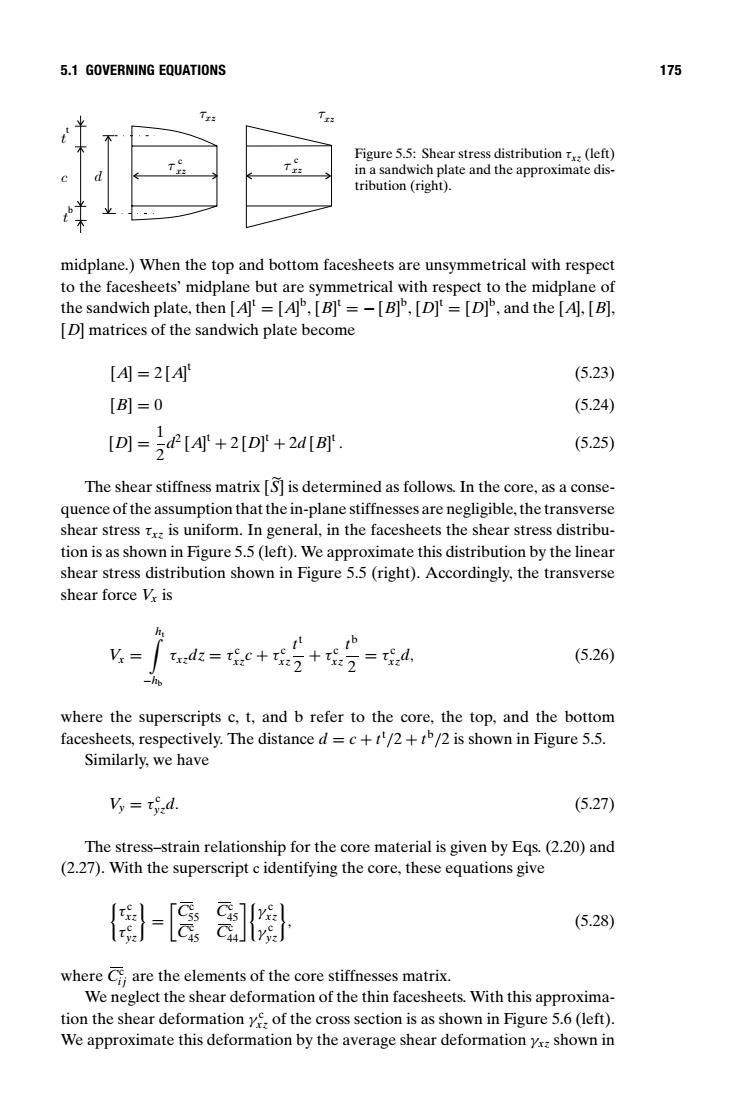正在加载图片...

5.1 GOVERNING EQUATIONS 175 Figure 5.5:Shear stress distribution x(left) in a sandwich plate and the approximate dis- tribution (right). midplane.)When the top and bottom facesheets are unsymmetrical with respect to the facesheets'midplane but are symmetrical with respect to the midplane of the sandwich plate,then [A]=[A],[B]=-[B],[D]=[D],and the [A],[B], [D]matrices of the sandwich plate become [A=2[A (5.23) [B=0 (5.24) [D]=2[4+2[D+2d[B. (5.25) The shear stiffness matrix [S]is determined as follows.In the core,as a conse- quence of the assumption that the in-plane stiffnesses are negligible,the transverse shear stress tx is uniform.In general,in the facesheets the shear stress distribu- tion is as shown in Figure 5.5(left).We approximate this distribution by the linear shear stress distribution shown in Figure 5.5(right).Accordingly,the transverse shear force V is Vx= :dk=+2+2=4 (5.26) -h where the superscripts c,t,and b refer to the core,the top,and the bottom facesheets,respectively.The distance d=c+t2+t/2 is shown in Figure 5.5. Similarly,we have Vy =t d. (5.27) The stress-strain relationship for the core material is given by Eqs.(2.20)and (2.27).With the superscript c identifying the core,these equations give 骨-[] (5.28) where C are the elements of the core stiffnesses matrix. We neglect the shear deformation of the thin facesheets.With this approxima- tion the shear deformation ye of the cross section is as shown in Figure 5.6(left). We approximate this deformation by the average shear deformation ys:shown in5.1 GOVERNING EQUATIONS 175 τxz τxz t b t t c d c xz τ c xz τ Figure 5.5: Shear stress distribution τxz (left) in a sandwich plate and the approximate distribution (right). midplane.) When the top and bottom facesheets are unsymmetrical with respect to the facesheets’ midplane but are symmetrical with respect to the midplane of the sandwich plate, then [A] t = [A] b , [B] t = − [B] b , [D] t = [D] b , and the [A], [B], [D] matrices of the sandwich plate become [A] = 2 [A] t (5.23) [B] = 0 (5.24) [D] = 1 2 d2 [A] t + 2 [D] t + 2d [B] t . (5.25) The shear stiffness matrix [S ] is determined as follows. In the core, as a consequence of the assumption that the in-plane stiffnesses are negligible, the transverse shear stress τxz is uniform. In general, in the facesheets the shear stress distribution is as shown in Figure 5.5 (left). We approximate this distribution by the linear shear stress distribution shown in Figure 5.5 (right). Accordingly, the transverse shear force Vx is Vx = ) ht −hb τxzdz = τ c xzc + τ c xz tt 2 + τ c xz tb 2 = τ c xzd, (5.26) where the superscripts c, t, and b refer to the core, the top, and the bottom facesheets, respectively. The distance d = c + tt /2 + tb/2 is shown in Figure 5.5. Similarly, we have Vy = τ c yzd. (5.27) The stress–strain relationship for the core material is given by Eqs. (2.20) and (2.27). With the superscript c identifying the core, these equations give
τ c xz τ c yz = Cc 55 Cc 45 Cc 45 Cc 44 !
γ c xz γ c yz , (5.28) where Cc i j are the elements of the core stiffnesses matrix. We neglect the shear deformation of the thin facesheets. With this approximation the shear deformation γ c xz of the cross section is as shown in Figure 5.6 (left). We approximate this deformation by the average shear deformation γxz shown in�